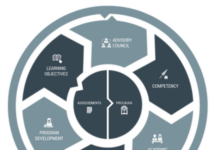Image: © Allen Interactions, 2014
[Note: there was a similar post on this site on January 6. The post was accidentally destroyed during site maintenance. This replaces it as a re-write.]
Bob Little (2104) The fifth annual, top ten e-learning movers and shakers Industry Today, January 2
It is interesting to note how the terminology changes over time. It seems that e-learning is now a term referring mainly to corporate training, while online learning is now more associated with k-12 and post-secondary education. How or why this has happened though beats me.
Certainly, this post is about corporate e-learning. I recognized very few names among the 70 or so writers and bloggers listed here (ones I do know are Elliott Masie, who was the top listed mover and shaker for the second year running, Harold Jarche, Jay Cross, Clark Quinn, and Donald Clark.)
This suggests I should spend more time following what’s happening in corporate e-learning, as I think both sectors can learn from each other, even recognizing that they are very different markets. For instance I suspect that corporate e-learning has far more experience in using simulations than would be the case for universities or even two-year colleges (high cost to develop, but high returns in performance). But maybe I’m wrong. What do you think?
Anyway, if you want to know what’s happening in corporate e-learning, Industry Today’s list would be a good place to start.










 Dr. Tony Bates is the author of eleven books in the field of online learning and distance education. He has provided consulting services specializing in training in the planning and management of online learning and distance education, working with over 40 organizations in 25 countries. Tony is a Research Associate with Contact North | Contact Nord, Ontario’s Distance Education & Training Network.
Dr. Tony Bates is the author of eleven books in the field of online learning and distance education. He has provided consulting services specializing in training in the planning and management of online learning and distance education, working with over 40 organizations in 25 countries. Tony is a Research Associate with Contact North | Contact Nord, Ontario’s Distance Education & Training Network.


Hi
I make the differentiation between e-learning and online learning a little differently. To me e-learning is self-paced training, where online learning involves some form of learner learner interaction. With this in mind, it’s true that the corporate sector often does e-learning, because their model is much more about short interactions that often don’t involve the teacher and learner talking to each other or learners talking to each other. Where in higher education, it’s much more about the longer duration courses and instructors and learners talking to each other. As for simulation, I believe it’s more government funded activities, such as aerospace and health professions & medical education (possibly military?) where simulation is common.
Cheers
Rebecca